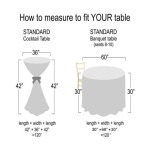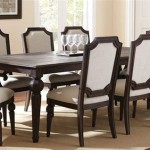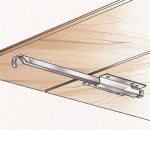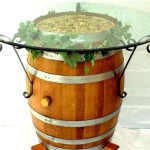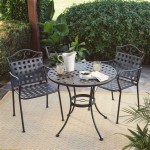Making a Kitchen Table: A Guide to Crafting a Heart of the Home
The kitchen table, a seemingly simple piece of furniture, holds immense significance in the fabric of a home. Beyond its functional purpose of providing a space for meals, it serves as a gathering point for families, friends, and cherished memories. The process of making a kitchen table, therefore, transcends mere carpentry; it becomes an act of creation, infusing a space with warmth, personality, and a tangible connection to the people who inhabit it. This guide aims to provide an understanding of the key points involved in making a kitchen table, equipping aspiring woodworkers with the knowledge and inspiration to craft their own unique and cherished centerpiece.
Designing the Dream Kitchen Table
The journey begins with a vision, a clear picture of the ideal kitchen table. This involves considering not only aesthetic preferences but also practical aspects. What style complements the existing kitchen design? How many people will regularly gather around the table? What materials align best with the desired durability and visual appeal? Will the table be primarily for dining or also serve as a workspace? The answers to these questions will help define the dimensions, shape, and features of the table. For instance, a rectangular table best suits formal gatherings, while a round table fosters intimacy. Consider incorporating features such as leaf extensions for expandable seating or drawers for storage.
A crucial aspect of design is choosing the right type of wood. Hardwoods such as oak, maple, and cherry offer strength, durability, and beautiful grain patterns. Softwoods like pine and cedar are often preferred for their affordability and ease of working. The choice of wood depends on the intended aesthetic, budget, and desired level of maintenance. For example, oak is known for its durability and classic appearance while walnut provides a rich, warm tone.
Beyond aesthetics, safety and ergonomics play a significant role in design. The table height must be comfortable for all users, taking into account chair height and the overall seating arrangement. A good rule of thumb is to ensure that the tabletop is 28-30 inches from the floor. Consider the placement of legs to provide ample legroom and avoid awkward angles. The design should incorporate stability and strength to withstand the daily rigors of use.
Crafting the Table with Skill and Precision
Armed with a well-defined design, the next step is to bring it to life through meticulous craftsmanship. The process involves carefully measuring, cutting, and joining wood pieces, ensuring precise alignment and smooth transitions. Basic woodworking skills are essential, including the ability to use hand tools like saws, chisels, and planes, and power tools such as routers, sanders, and drills. The specific tools required will depend on the complexity of the design and the available resources.
The method of joining wood pieces varies based on the design and desired durability. Traditional techniques like mortise and tenon joints offer strength and a classic aesthetic. Modern techniques like pocket holes and dowel joints provide faster construction while still maintaining stability. Precise cuts and careful assembly are critical to create a sturdy and visually appealing table. After joining, the wood is sanded to smooth out surfaces and prepare for finishing.
Finishing the table involves applying a protective layer that enhances its beauty and extends its lifespan. Options include stains, paints, varnishes, and oils, each offering distinct aesthetic and protective properties. Stains add color and accentuate the grain, while paints offer a solid color and a smoother finish. Varnishes provide a glossy, durable coating, while oils offer a natural, satin finish. The chosen finish should be compatible with the type of wood and the desired look and feel. Proper application technique is crucial to achieving a professional finish.
Adding Personal Touches: More Than Just a Table
A kitchen table is more than just a piece of furniture; it becomes a reflection of the family's personality and their unique story. This is where the opportunity arises to add personal touches, transforming the table into a treasured heirloom. Simple details like decorative inlays, carved designs, or hand-painted elements can infuse the table with character and meaning. The choice of finish can also add a personal touch. A distressed look, for example, evokes a sense of history and family legacy.
Incorporating family heirlooms or salvaged materials further adds a unique dimension. Old wood from a family farm, repurposed barn wood, or a piece of antique hardware can be used to create an element of sentimental value and a connection to the past. Even the choice of materials can reflect a family's values and lifestyle. Using sustainably sourced wood, for instance, expresses a commitment to environmental responsibility. The possibilities for personalization are endless, allowing each table to become a testament to the family's journey and shared experiences.

25 Diy Dining Tables Bob Vila

20 Gorgeous Diy Dining Table Ideas And Plans The House Of Wood

How To Build A Farmhouse Kitchen Table Complete And Easy Plan

How To Build A Kitchen Table With S Wikihow
:max_bytes(150000):strip_icc()/ana-white-farmhouse-table-56af6cb25f9b58b7d018abce.jpeg?strip=all)
14 Free Diy Woodworking Plans For A Farmhouse Table

How To Build A Farmhouse Dining Table Green With Decor

Build Your Own Kitchen Table Capturing Joy With Kristen De

Learn How To Make An Easy Build Diy Kitchen Table

How To Build A Kitchen Table With S Wikihow

Diy Small Farmhouse Table Plans And Tutorial

